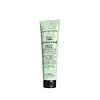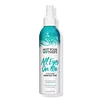What's inside
What's inside
 Key Ingredients
Key Ingredients

No key ingredients
 Benefits
Benefits

 Concerns
Concerns

 Ingredients Side-by-side
Ingredients Side-by-side

Water
Skin ConditioningDicaprylyl Carbonate
EmollientCetearyl Alcohol
EmollientPolyquaternium-37
Myristyl Alcohol
EmollientC12-15 Alkyl Benzoate
AntimicrobialMacrocystis Pyrifera Extract
Skin ConditioningLaminaria Saccharina Extract
Skin ProtectingChlorella Vulgaris Extract
Skin ConditioningLactobacillus Ferment
Skin ConditioningArgania Spinosa Kernel Oil
EmollientPyridoxine Hcl
Skin ConditioningPhytic Acid
Glycerin
HumectantHydrogenated Polyisobutene
EmollientEthylhexylglycerin
Skin ConditioningButylene Glycol
HumectantCaprylyl Glycol
EmollientPPG-3 Benzyl Ether Myristate
EmollientLauryl Glucoside
CleansingTocopherol
AntioxidantZinc Sulfate
AntimicrobialGuar Hydroxypropyltrimonium Chloride
Skin ConditioningBehentrimonium Chloride
PreservativePentylene Glycol
Skin ConditioningPropanediol
SolventVinyl Caprolactam/Vp/Dimethylaminoethyl Methacrylate Copolymer
Skin ConditioningPolyquaternium-11
Stearyl Alcohol
EmollientParfum
MaskingLimonene
PerfumingEugenol
PerfumingPentaerythrityl Tetra-Di-T-Butyl Hydroxyhydrocinnamate
AntioxidantSodium Benzoate
MaskingPhenoxyethanol
PreservativePotassium Sorbate
PreservativeWater, Dicaprylyl Carbonate, Cetearyl Alcohol, Polyquaternium-37, Myristyl Alcohol, C12-15 Alkyl Benzoate, Macrocystis Pyrifera Extract, Laminaria Saccharina Extract, Chlorella Vulgaris Extract, Lactobacillus Ferment, Argania Spinosa Kernel Oil, Pyridoxine Hcl, Phytic Acid, Glycerin, Hydrogenated Polyisobutene, Ethylhexylglycerin, Butylene Glycol, Caprylyl Glycol, PPG-3 Benzyl Ether Myristate, Lauryl Glucoside, Tocopherol, Zinc Sulfate, Guar Hydroxypropyltrimonium Chloride, Behentrimonium Chloride, Pentylene Glycol, Propanediol, Vinyl Caprolactam/Vp/Dimethylaminoethyl Methacrylate Copolymer, Polyquaternium-11, Stearyl Alcohol, Parfum, Limonene, Eugenol, Pentaerythrityl Tetra-Di-T-Butyl Hydroxyhydrocinnamate, Sodium Benzoate, Phenoxyethanol, Potassium Sorbate
Water
Skin ConditioningCetearyl Alcohol
EmollientBehentrimonium Chloride
PreservativePhenoxyethanol
PreservativeCaprylyl Glycol
EmollientSorbic Acid
PreservativeParfum
MaskingCyclopentasiloxane
EmollientCyclohexasiloxane
EmollientQuaternium-18
Methyl Gluceth-20
HumectantQuaternium-80
Cocodimonium Hydroxypropyl Silk Amino Acids
Skin ConditioningAloe Barbadensis Leaf Juice
Skin ConditioningMacadamia Ternifolia Seed Oil
EmollientHydrolyzed Keratin
HumectantButylene Glycol
HumectantHelianthus Annuus Seed Extract
Skin ConditioningDisodium EDTA
Citric Acid
BufferingWater, Cetearyl Alcohol, Behentrimonium Chloride, Phenoxyethanol, Caprylyl Glycol, Sorbic Acid, Parfum, Cyclopentasiloxane, Cyclohexasiloxane, Quaternium-18, Methyl Gluceth-20, Quaternium-80, Cocodimonium Hydroxypropyl Silk Amino Acids, Aloe Barbadensis Leaf Juice, Macadamia Ternifolia Seed Oil, Hydrolyzed Keratin, Butylene Glycol, Helianthus Annuus Seed Extract, Disodium EDTA, Citric Acid
 Reviews
Reviews

Ingredients Explained
These ingredients are found in both products.
Ingredients higher up in an ingredient list are typically present in a larger amount.
This ingredient is a preservative and often used for it's anti-static properties. You'll most likely see this ingredient in hair conditioners.
It does not cause irritation or sensitization in leave-on products at 1-5%.
Butylene Glycol (or BG) is used within cosmetic products for a few different reasons:
Overall, Butylene Glycol is a safe and well-rounded ingredient that works well with other ingredients.
Though this ingredient works well with most skin types, some people with sensitive skin may experience a reaction such as allergic rashes, closed comedones, or itchiness.
Learn more about Butylene GlycolCaprylyl Glycol is a humectant and emollient, meaning it attracts and preserves moisture.
It is a common ingredient in many products, especially those designed to hydrate skin. The primary benefits are retaining moisture, skin softening, and promoting a healthy skin barrier.
Though Caprylyl Glycol is an alcohol derived from fatty acids, it is not the kind that can dry out skin.
This ingredient is also used as a preservative to extend the life of products. It has slight antimicrobial properties.
Learn more about Caprylyl GlycolCetearyl alcohol is a mixture of two fatty alcohols: cetyl alcohol and stearyl alcohol. It is mainly used as an emulsifier. Emulsifiers help prevent the separation of oils and products. Due to its composition, it can also be used to thicken a product or help create foam.
Cetearyl alcohol is an emollient. Emollients help soothe and hydrate the skin by trapping moisture.
Studies show Cetearyl alcohol is non-toxic and non-irritating. The FDA allows products labeled "alcohol-free" to have fatty alcohols.
This ingredient is usually derived from plant oils such as palm, vegetable, or coconut oils. There is debate on whether this ingredient will cause acne.
Due to the fatty acid base, this ingredient may not be Malassezia folliculitis safe.
Learn more about Cetearyl AlcoholParfum is a catch-all term for an ingredient or more that is used to give a scent to products.
Also called "fragrance", this ingredient can be a blend of hundreds of chemicals or plant oils. This means every product with "fragrance" or "parfum" in the ingredients list is a different mixture.
For instance, Habanolide is a proprietary trade name for a specific aroma chemical. When used as a fragrance ingredient in cosmetics, most aroma chemicals fall under the broad labeling category of “FRAGRANCE” or “PARFUM” according to EU and US regulations.
The term 'parfum' or 'fragrance' is not regulated in many countries. In many cases, it is up to the brand to define this term.
For instance, many brands choose to label themselves as "fragrance-free" because they are not using synthetic fragrances. However, their products may still contain ingredients such as essential oils that are considered a fragrance by INCI standards.
One example is Calendula flower extract. Calendula is an essential oil that still imparts a scent or 'fragrance'.
Depending on the blend, the ingredients in the mixture can cause allergies and sensitivities on the skin. Some ingredients that are known EU allergens include linalool and citronellol.
Parfum can also be used to mask or cover an unpleasant scent.
The bottom line is: not all fragrances/parfum/ingredients are created equally. If you are worried about fragrances, we recommend taking a closer look at an ingredient. And of course, we always recommend speaking with a professional.
Learn more about ParfumPhenoxyethanol is a preservative that has germicide, antimicrobial, and aromatic properties. Studies show that phenoxyethanol can prevent microbial growth. By itself, it has a scent that is similar to that of a rose.
It's often used in formulations along with Caprylyl Glycol to preserve the shelf life of products.
Water. It's the most common cosmetic ingredient of all. You'll usually see it at the top of ingredient lists, meaning that it makes up the largest part of the product.
So why is it so popular? Water most often acts as a solvent - this means that it helps dissolve other ingredients into the formulation.
You'll also recognize water as that liquid we all need to stay alive. If you see this, drink a glass of water. Stay hydrated!
Learn more about Water